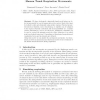Free Online Productivity Tools
i2Speak
i2Symbol
i2OCR
iTex2Img
iWeb2Print
iWeb2Shot
i2Type
iPdf2Split
iPdf2Merge
i2Bopomofo
i2Arabic
i2Style
i2Image
i2PDF
iLatex2Rtf
Sci2ools
CVRMED
1997
Springer
1997
Springer
Physically-based model for simulating the human trunk respiration movements
Abstract. We have developped a physically-based model where an object is represented by a set of mass points on its contour. Each object may be defined locally and physically using surface regions. Physical properties (such as elasticity, motor functioning, or rigidity) can be assigned to the regions. Physical constraints, like incompressibility (i.e. constant volume deformation), can be set. Moreover, additional constraints can be used to control the animation and the object behaviour (e.g. nailed point, pre-defined trajectory). Depending on this physical properties and constraints, forces and movements are deduced. Using this model, we can handle bio-mechanical movements. Our simulation provides an anatomical and functional model of the evolutions of the human trunk structures during respiration.
Computer Vision | Constant Volume Deformation | CVRMED 1997 | Physical Properties | Physically-based Model |
| Added | 07 Aug 2010 |
| Updated | 07 Aug 2010 |
| Type | Conference |
| Year | 1997 |
| Where | CVRMED |
| Authors | Emmanuel Promayon, Pierre Baconnier, Claude Puech |
Comments (0)

